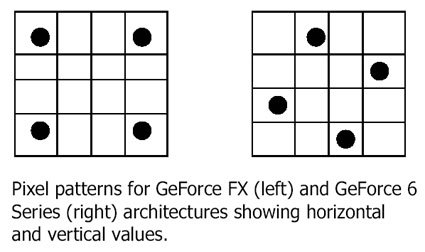Performance Leap: NVIDIA GeForce 6800 Ultra
Displacement Mapping
The vertex pipelines also allow the NV40 chip to display displacement mapping. This is a technique that generates (Z) geometry data from textures.
In effect, this is an easy way for creating geometry data. NVIDIA used a dinosaur model as an example whose complex model was created using displacement mapping. Using this technique, game developers can easily create very complex shapes without forcing older graphics cards to their knees. These would just revert to the simplified base vertex model plus normal textures.
IntelliSample 3.0
NVIDIA has also reacted to the criticism concerning the image quality offered by its anti aliasing (FSAA) implementation. NV40 will be the first NVIDIA product to offer a rotated-grid subpixel pattern. Nonetheless, the maximum number of samples will remain at 4 (4xFSAA for MultiSampling). The 8x mode appearing in the drivers is a mixed mode, featuring 4x Multisampling + 2x SuperSampling.
The trouble with the subpixel pattern that all NVIDIA cards have used until now is that due to its straight orientation, object borders that were nearly fully vertical or horizontal displayed very pronounced aliasing artifacts. The new, rotated grid pattern promises to solve this problem.
In addition to the improved edge-smoothing in difficult areas, the new sub pixel pattern also improves color representation, since all horizontal and vertical areas of the sub pixel are taken into account.
Image quality comparisons further down in the article will answer the question whether this improvement will allow NV40 to catch up with ATi's image quality. After all, ATi's cards offer not only higher FSAA modes (up to six sub pixel), but also a gamma correction tool.
Get Tom's Hardware's best news and in-depth reviews, straight to your inbox.
Current page: Displacement Mapping
Prev Page Possible Applications And Other Peculiarities Next Page More Goodies
